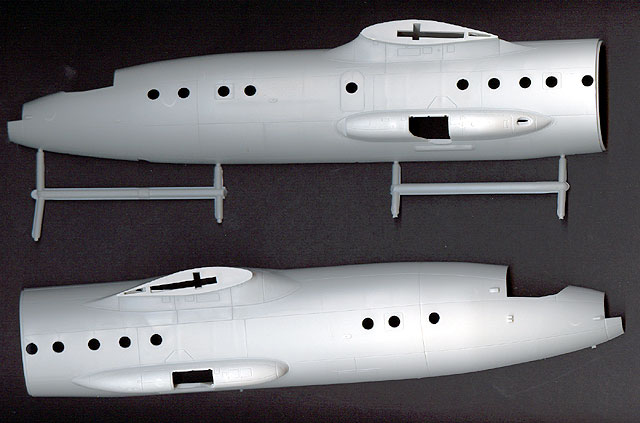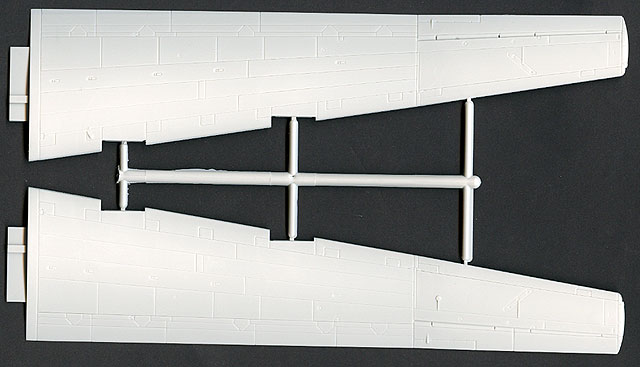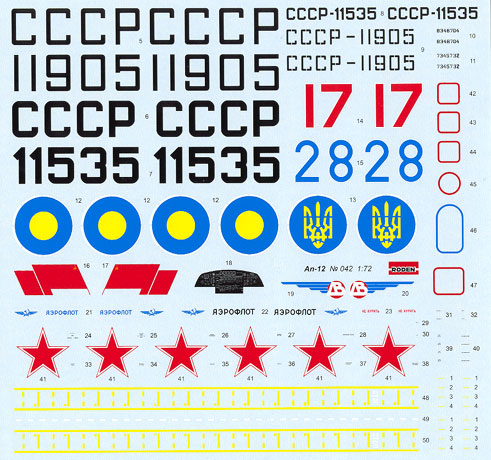S
u m m a r y
|
| Catalogue Number: |
RD0042 |
| Scale: |
1/72 |
| Contents and Media: |
280 parts in injection moulded
styrene; four decal options. |
| Price: |
USD$44.96
from Squadron.com |
| Review Type: |
First Look |
| Advantages: |
Spectacular size and subject; finely
engraved panel lines; convenient parts breakdown for large fuselage;
nicely detailed interior; good instructions and decals; excellent clear
parts (and engineering of clear parts). |
| Disadvantages: |
Some surface detail slightly soft. |
| Recommendation: |
Highly Recommended |
Reviewed by
Jennings Heilig

Roden's 1/72 scale
An-12BK is available online from Squadron.com
If you had visions, as I did, of the Toko (Roden's former incarnation)
1/72 He111 family or other items equally as ill-fitting and poorly engineered,
rest easy. THIS IS AN INCREDIBLE KIT!!
Roden's 1/72 scale An-12BK is easily the best ever kit of a large Soviet
type, be it bomber, transport, or whatever else. This kit was obviously done by
someone very knowledgeable of both the aircraft itself and of the technical
aspects of kit design and execution. On a first dry run the fit just about
everywhere is as close to perfect as I've seen (even including Tamiya here), and
the overall impression is just spectacular. Breathtaking really, for those of us
who have long hungered for almost anything Soviet that was halfway accurate.
To say that I'm stunned with the quality of this kit would be a gross
understatement. It is truly amazing, especially given that its origins are in
Ukraine. These guys are going to be giving the Japanese and Koreans a real run
for their money before long.
The kit is molded in ICM-like light grey styrene, and in fact, the plastic
itself reminds me a little of ICM's - perhaps a bit on the soft side, but
very crisply molded and, unlike ICM, virtually flash-free. All of the panel
detail is extremely nicely engraved. Not quite as delicate as Hasegawa perhaps,
but certainly exquisitely done. There are a couple of very minor places where
the panel detail is a tad mushy, but it's nothing to spoil the effect of the
rest of it. Fortunately, Roden has dispensed with ICM's and Trumpeter's
irritating habit of molding all the control surfaces separately, and the
engraving for them is just perfect. The kit represents a late production An-12BK
version which had a slightly larger rear cargo hatch setup with teardrop
fairings over the hinges than the earlier An-12 had. Backdating would be easy or
hard, depending on whether you wanted to open the hatch up or not. Frankly, as
the An-12BK was the main production version, I'd leave it alone.
One thing that Roden could have done would have been to provide both
the earlier Toadstool (the NATO ASCC name) chin radome and the later Puffball as
options. You only get the Puffball radome with this release.
The fuselage is split very conveniently into four sections, but the fit of all
four parts (albeit without any of the innards inside it - more on that later) is
nearly perfect. No sink marks, no problems that I can see thus far. I suspect
Roden may have done the fuselage this way for two reasons. First, they may not
have had access to a molding machine that was big enough to take the entire
fuselage. Second, by molding the entire back end from the production break at
the cargo door hinge point back as a separate sprue, they could feasibly cut
another few pieces and get an An-10 airliner out of these basic core molds. I
doubt that would be a very profitable undertaking, as the An-10 wasn't the most
successful Soviet airliner, but it was built and it was flown in service by both
Aeroflot and the VVS, so anything is possible.

They could also mold a new rear end for the earlier An-12s without the
teardrop fairings at the cargo door hinges if they wanted to (yes please!). Also
done as a separate assembly is the tail gun position. This also bodes well for
the possibility for other Cub variants. See Roden's web site (
www.rodenplant.com ) for the
announcement of the forthcoming An-12BK-PPS later this year. I surely hope we'll
also see a purely civilian (if there was such a thing in the USSR) An-12B with
the faired over tail position in the future. Aeroflot had some very pretty (and
very 1950s looking) civil schemes on their An-12B fleet.
Wings are molded in two pieces each, including very precisely fitting upper and
lower halves with control surfaces molded equally well as the others.

You do have to remove a bit of excess plastic inside the fuselage halves
where the slot for the wing tongues goes, but it took me about 15 seconds per
side. That done, you're treated to a nearly flawless wing/fuselage fit. The
outboard 3š anhedral is molded in, so there's no messing it up. The nacelles are
made up of several parts each, and are a bit fiddly, especially the rear part
where the engine exhaust is located. Just be careful here and be pepared to use
a bit of filler. Nacelle fit to the wings looks good. The props are very nicely
done, and by simply removing a small collar at the base of each blade's hub, you
can paint them and add them separately after the rest of the model's assembly
and painting are complete. Note that the An-12's props rotate clockwise when
viewed from the front, that being opposite of most US types. Horizontal stabs
are also upper and lower pieces for each side, and again, the fit is nearly
perfect.
Clear parts are one of the real gems in this one. The entire cockpit cab section
is molded as one piece (like the Heller 707), and the shape, window shape, and
fit are spot-on the money. Ditto for the nose glazing. The cab and nose glazing
are molded with nice clear (albeit slightly thick) window sections, and the
frame areas are very lightly frosted. Should make for easy masking and painting.
Each round cabin window is molded separately, so you could leave them out and
use Krystal Kleer or 5-minute epoxy for those if you wanted to skip the masking.
The cockpit and the cargo bay are nicely, but not overly detailed. You have the
option of cutting and mounting the cargo doors at the rear in the open position,
and Roden thoughtfully provide a set of stairs which are inevitably seen leading
up to the port side entry hatch on parked An-12s as well as a set of ramps for
the cargo bay (the crew entry door is molded shut). Interestingly the An-12
never had a self-contained door/ramp like the C-130, nor even a pressurized
cargo bay for that matter. Very odd. You could really go wild (if you can find
good reference photos) doing up the innards of this one, but almost all of it
will be for naught unless you're doing a cutaway model. What is provided is more
than adequate to give the impression of detail. Folding troop seats (a whooooole
bunch of 'em) are provided, as are both floor and ceiling parts. The area around
the rear cargo doors has some nice structural detail molded in, and you add in
the hinge beam and some partial bulkheads to complete that area. The aft most
bulkhead even has the hatch for access to the turret molded in.
Landing gear is like the real thing - simple and rugged. Roden has very
accurately captured the later style spoked main wheels (no need for aftermarket
at all that I can see), and the way the gear struts are done looks very
convincing. The main gears look like they might possibly be a bit fiddly to
construct, and I wouldn't be tempted to play "assault landing" with my model,
given their minimal mounting surfaces. The nose gear strut has a small plate at
its upper end which fits into a shallow recess in the fuselage. Again, that
might not be the strongest method of mounting, so be careful. The struts
themselves are very nicely molded and detailed, even including separate scissor
links, etc.
Click the thumbnails below to view
larger images:
The instruction sheet is obviously computer generated, and looks
very good. Each step is very well illustrated, and there's even a small errata
sheet.
The decal sheet is HUGE, and is extremely well printed. It covers two
"Aeroflot" machines, one Russian Air Force, and one Ukranian Air Force machine,
all in the rather drab VVS light grey scheme. The Aeroflot examples are actually
VVS and carry minimal Aeroflot markings. One is labelled as being from the 1980
period of the Afghan conflict, the other is labelled as being one which supplied
the Egyptians during the 1973 war with Israel. The Russian AF example is from
1997, and the Ukranian one is from 1992.

You get complete national markings for all examples, plus a nice selection of
stencilling and safety markings - even including the floor markings for the
cargo bay! Very nicely done.
Overall I'd rank this kit much closer to the Japanese end of the quality
spectrum than even the Trumpeter end. It's a major improvement over items like
the Trumpeter Tu-16 and Su-15 kits (how I wish Roden had done the Badger!), and
is every bit as good as anything else that's out there these days. If you have
the slightest interest in things Soviet, get yourself one of these babies and
you won't be disappointed. Let's hope Roden keeps up the good work and perhaps
we'll see some other much-needed Soviet types emerge from them.
Na zdrovye Roden!!
Highly Recommended.
J
Review and Images Copyright © 2002 by
Jennings Heilig
Page Created 13 August, 2002
Last updated 22 July, 2003
Back to HyperScale Main Page
Back to Reviews Page
|
Home | What's
New | Features
| Gallery |
Reviews | Reference
| Forum
| Search